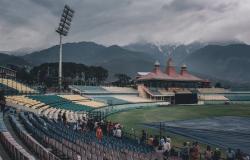West Indies and India, Cricket and the Global Pulse

Brian Stoddart explores the rise and dominance of Indian cricket.
As America’s Professional Golf Association (PGA) Tour arm wrestles Saudi Arabia’s Public Investment Fund (PIF) and it’s LIV Golf offshoot for golf’s global future, some consequences of globalised sport were played out on a dustbowl cricket pitch in the Caribbean island of Dominica and another in Grand Prairie, Texas.
Cricket, the English game taken around the world with the British Empire, took root immediately in settler communities then, over time, transferred into local ones. England was long the authority on the game in both playing and governance realms before countries like South Africa and Australia grew in strength. As independence came and Empire faded into Commonwealth, teams like Pakistan rose to prominence but none reached the heights attained by West Indies in the 1970s and 80s.
As C L R James recorded in Beyond a Boundary, Caribbean cricket was as much a vehicle for social resistance by formerly enslaved communities as it was a mere game. Admitted to test match playing status in the 1920s, West Indies beat England in England in 1950 as the Windrush generation settled in while the fight for independence continued in the Caribbean game’s island and territory constituencies. This was about colour, caste and class, and reached its peak in the 1970s and1980s team led by Clive Lloyd that carried all before it and whose social value was demonstrated in the later documentary, Fire in Babylon.
But at the very moment of triumph, there were signs of change. West Indies won the first two World Cups in 1975 and 1979, but India won in 1983 and that, arguably, marked the real beginning of the game’s globalisation. To that point, India was an enthusiastic follower of the game but a minnow in playing ability, but 1983 changed that because the country had a huge popular base for the game, a nascent economic platform to nourish it, and a growing awareness of governance and political strength. All that was harnessed by Jagmohan Dalmiya’s galvanisation of all the world’s minor cricket nations to vote as a bloc in the game’s politics. That won India World Cup host status in 1987.
From that point, India rose inexorably to be both a playing and a political force in world cricket, eventually forcing the International Cricket Council to relocate from London to Dubai. The final piece in the globalisation jigsaw came with the 2008 inauguration of the Indian Premier League that capped the rise of T20 limited overs cricket as the game’s main form, and also began to skew mobilisation of the game’s playing workforce. India was now running the global game.
So when a few days ago in Roseau, Dominica India thrashed home side West Indies three days into a five day match, that simply confirmed how the cricket roles of the two sides had been reversed in the space of forty years.
But what of Grand Prairie, Texas? That has signalled the start of matches in Major League Cricket in the United States following a few years of preliminary play. Several matches will be played there in T20 form before moving on to Morrisville, North Carolina. These matches all involve players from a host of cricket nations.
Even that quick description, though, masks some of the important features that change and, in some respects, challenge the game’s global future.
For example, among the MLC teams are MI New York, LA Knight Riders, Texas Super Kings, and Seattle Orcas. The first three are all sub-franchises of India Premier League teams: Mumbai Indians (owned by the industrialist Ambani family), Kolkata Knight Riders (movie star Shah Rukh Khan) and Chennai Super Kings (Narayanaswami Srinivasan of India Cements who is also a former India and International Cricket Council boss). The Seattle Orcas are following in that tradition with India-origin Satya Nadella of Microsoft a major investor.
And there is a further dimension still, because all those IPL teams are hosting franchises in T20 cricket leagues around the world: West Indies itself, the United Arab Emirates, South Africa and the United States.
In turn, that is changing prospects for leading international players with several Australian players, for example, approached by these franchises to sign twelve month a year contracts to play in those T20 teams around the world. That is simply the latest stage of a process where Indian funds have changed the game.
Therein lies one of the main reasons for West Indies current playing ill fortunes. Given India’s escalating financial, governance and playing dominance in the past forty years, West Indies has fallen further and further behind in all respects where they were once all-powerful. It is now far more lucrative for leading Caribbean players to appear in those Indian franchise teams than to play at or even for home sides. That has caused a huge rift inside Caribbean cricket with much finger pointing at who or what has been to blame for all this.
Those fissures are appearing elsewhere in the cricket world as players for smaller nations not in receipt of major slabs of the global cricket revenue distribution see their future security lying with those growing franchises.
India’s rising cricket power, then, has shifted the very forms in which the game is played around the world, changed the priorities of many players in many places, and pressured governance bodies in smaller cricketing powers to alter their ways of doing things.
That is essentially what the LIV Golf-PGA conundrum promises, and the arrival of private equity investment in sports like rugby union’s New Zealand’s All Blacks promises to do much the same.
For all those reasons, international sports change is not just a result of but a major cause of global change that demands a new set of strategic, management and visionary skills among those who run those sports. They need to see the links to all those wider globalising forces.
Photo by Aalekh Deval


